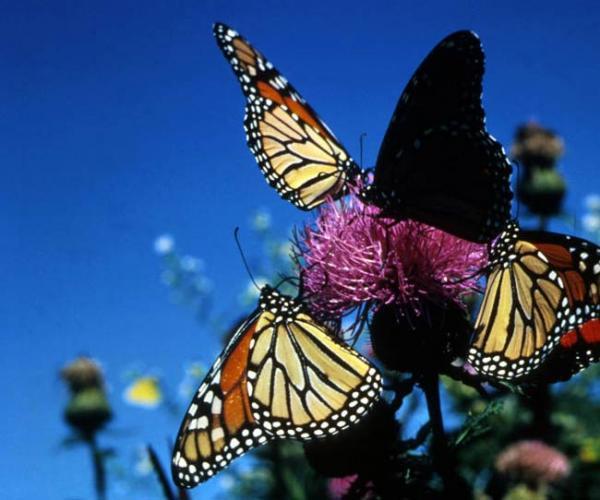
Monarchs Face a Tough Winter Migration Road

Each year, a mysteriously long-lived generation of monarch butterflies makes the harrowing trek from its birthplace in southern Canada and the northern United States to the species' wintering grounds in a patch of forest in Mexico, and this year, scientists are concerned that historic drought conditions along the way may have taken a toll on the colorful insects.
"I call that a thousand miles of hell, from Oklahoma down to Mexico," said Chip Taylor, a professor and insect ecologist at the University of Kansas, and the director of Monarch Watch, a nonprofit outreach organization.
The butterflies' traditional migration route takes them right through Texas — a region in the firm grip of one of the worst droughts on record — and the monarchs can only survive so long without water or nectar, Taylor told OurAmazingPlanet.
The state of this so-called "super-generation" — which flies from Canada to Mexico, in contrast to the three or four generations that hatch and die as the monarchs move from Mexico to Canada — plays an outsize role in how the species will fare the following year, and scientists are keeping a close eye on initial (yet very unofficial) reports from Mexico on how many butterflies have made it so far. [Ten Species Success Stories]
Taylor said he's heard news that roughly 10 acres (4 hectares) of forest are now covered by the butterflies — but he emphasized that the number is expected to change significantly in the coming weeks.
As the weather cools, the monarchs consolidate and move closer together. In addition, butterflies will continue to trickle in through the first week of December, so it's too early to know just how much space the insects will cover once they're truly settled in for the winter.
In recent years, winter monarch colonies appear to be shrinking. Since 1994, the average coverage is 18 acres (7 hectares), but the lowest numbers ever recorded have all occurred in the last 11 years, with a new record low in 2009 of a mere 5 acres (2 hectares).
Get the world’s most fascinating discoveries delivered straight to your inbox.
In addition to sheer numbers of butterflies, their physical condition when they arrive is important too, Taylor said. Typically, the journey through Texas provides enough nutrients that the butterflies fatten up ahead of their winter torpor, yet this year's drought may have forced them to fly right through the state, limiting access to food and water.
"They can live off of their fats a little bit, but if they're living off of them, that's not a good thing because they need those fats to live through the winter," Taylor said.
Although the majority of the butterflies have likely already arrived among the trees where they will pass the winter months — the same stretch of Michoacán pine forest in central Mexico, where the monarchs return year after year, despite hatching thousands of miles away — an official measure of the size of the population won't be available until mid-December.
Monarch populations have faced significant declines over the last two decades, hit hard by a steep reduction in milkweed across North America, the only plant upon which the butterflies lay their eggs. Due to herbicide use and farming practices in the United States, milkweed has disappeared from some 140 million acres in the last 10 years, Taylor said.
It's still not clear how well this year's monarch population survived their journey south, he said, since it's hard to assess how many butterflies survived, and how much fat they've stored ahead of winter.
"It's one step at a time," Taylor said, "but what they did to get through Texas could have consequences all the way into early next summer."
This story was provided by OurAmazingPlanet, a sister site to LiveScience. Reach Andrea Mustain at amustain@techmedianetwork.com. Follow her on Twitter @AndreaMustain.
